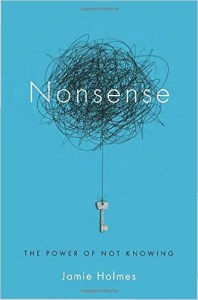Nonsense: The power of not knowing by Jamie Holmes (Crown Publishing, 2015): Review by Robert M Ellis
This highly engaging, accessible book introduces a range of research relating to uncertainty and ambiguity through the medium of stories. The focus throughout is on the ways we limit ourselves through premature closure, seeking clarity and certainty that we impose upon a world that is always less clear and less certain than we expect. But the emphasis is also often positive, showing how tolerance of uncertainty, ambiguity and failure can make us more successful in the goals we seek.
The extended examples range from language learning to racial prejudice, via fashion marketing, motor-cycle racing and invention. Holmes draws frequently on psychological evidence showing the relationship between our attitude to uncertainty and our experience of stress: too much uncertainty can make us feel stressed, but too much stress can also make it harder for us to deal with uncertainty. The urge for certainty also constantly cramps our ability to understand the world and respond to it creatively. So, a distinctive language teacher manages to produce remarkable results just by putting reluctant teenage students a little more at their ease; a fashion chain beats the competition by redesigning the supply chain holistically rather than focusing only on sections of it; a motor-cycle racing team is undermined by the complacency of success, but galvanised by failure; inventors start to think about new possibilities more creatively when they start considering the properties of things apart from their accustomed use; and a bilingual school manages to erode the massive barriers between Israeli and Palestinian communities by training children equally in both their languages.
This book is concerned with the Middle Way in the sense that it offers lots of evidence, as well as inspiring stories, of the benefits of dwelling as long as we can in the ambiguous middle. However, it says nothing about negative certainties, so in that sense does not engage with the need for balance between absolutes as a key feature of the Middle Way. It does discuss the value of breadth of experience in providing us with new meaning that can help us develop new more adequate beliefs, and there is some broad discussion of cognitive biases. However, there is no concept of practice here, or much idea conveyed that we can work on our openness to uncertainty and ambiguity. Meditation does not get any mention, despite its crucial usefulness in enabling us to engage creatively with uncertainty as well as reducing stress.
So, this is a well-written and user-friendly book, but rather superficial. The lengthy examples are full of details that are entirely incidental to the points being explored, and the emphasis on narratives rather comes at the expense of increasing our insights into the subject. This might still suit the audience that the author has in mind, but I felt that the absence of any concept of practice rather limited the helpfulness of the book to any audience, even a popular one that might be put off by too much depth in other respects. Nevertheless, I shall continue to value this book as a source of helpful stories and examples.
